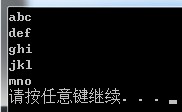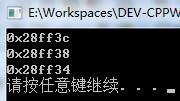一、字符串指针
字符串是一种特殊的char型数组,指向char类型数组的指针,就是字符串指针。与普通指针一样,字符串指针在使用前也必须定义。字符串与char数组的区别在于长度,字符会自动在尾部加上一个长度‘\0’,而char型数组的长度就是其字符的个数。字符串长度是字符个数+1。例:
#include<iostream>
using namespace std;
int main()
{
char str[]="hello world";
char *p=str;
cout<<str<<endl;
cout<<p<<endl;
cout<<*p<<endl;
system("pause");
}

二、char型指针数组
指针数组的元素是指针。与普通指针类似,指针数组在使用前也必须先赋值,否则可能指向没有意义的值,这是比较危险的。以char型指针数组为例。
int main()
{
char *p[5]={"abc","def","ghi","jkl","mno"};
for(int i=0;i<5;i++)
puts(p[i]);
system("pause");
}

对于int型数据,如下:
#include<iostream>
using namespace std;
int main()
{
int a=1,b=2,c=3;
int *p[]={&a,&b,&c};//不能写成int *p[]={1,2,3},这是不合法的。
for(int i=0;i<3;i++)
cout<<p[i]<<endl;//打印出地址(指针)
system("pause");
}

三、对比int型和char型数组的数组名和取地址
#include<iostream>
using namespace std;
int main()
{
int a[]={1,2,3};
char b[]={'a','b','c'};
cout<<a<<endl;
cout<<&a<<endl;
cout<<b<<endl;
cout<<&b<<endl;
system("pause");
}

更多详细信息请查看 java教程网 http://www.itchm.com/forum-59-1.html